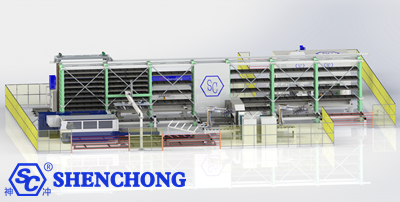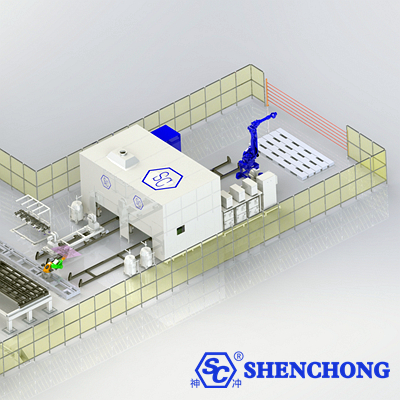
As a typical equipment of industrial automation, industrial robots promote the development of all walks of life in economic activities. The sheet metal industrial robot palletizing has the advantages of low cost and efficient operation, liberating people from the heavy and single plate stacking work. Improve production efficiency, reduce production costs, and shorten production cycles.
Plate palletizing robots can replace manual workpiece classification, transportation, loading and unloading. In particular, it replaces humans in carrying dangerous items, such as radioactive materials, toxic substances, etc., reducing workers' labor intensity and ensuring workers' personal safety. Realize automation, intelligence and unmanned operation.
The sheet metal industrial robot palletizing system mainly picks and sorts raw materials and workpieces on the assembly line during the production and manufacturing process. Especially in sheet metal warehousing, the working efficiency of the palletizing robot directly determines the throughput of the sheets. Therefore, the use of robot palletizing to achieve automated production is an effective means to promote enterprise development.

In practical applications, the industrial robot palletizing system does not work independently by the robot, but cooperates with the automation equipment to perform systematic work.
Industrial robot palletizing systems generally consist of four subsystems. The electrical control subsystem controls the workflow and rhythm of the entire palletizing system. The material transfer subsystem transfers materials to the robot work area. The robot places the item pick code onto the automated pallet system. When the robot finishes stacking a stack of sheets, the automatic pallet conveying system automatically transfers them to the designated location and is transported by a forklift or other transfer equipment.
- Palletizing robot system: robot body, robot controller, robot gripper, safety guardrail and base, etc.
- Automatic pallet conveying system: pallet warehouse, light/heavy load conveyor, heavy load roller line, lift/lower transplanter, etc.
- Material conveying system: belt conveying line, pneumatic pushing device, linear slide, spiral slide, turning roller line, upper flattening device, lower vibration conveying line, material shaping device, U-turn device, etc.
- Electrical systems: PLC, gas circuit equipment, transformers, detection sensors, power motors, etc.
- High-precision positioning, fast handling and clamping.
- Shorten the work cycle and improve production efficiency.
- Robot operation is stable and reliable, reducing work errors and improving product quality.
- Continuous operation without fatigue, working around the clock, expanding factory production capacity.
- Simple structure with few parts.
- Low failure rate, reliable performance, simple maintenance and repair.
- Small footprint. Conducive to the layout of production lines in customer factories. And a larger warehouse area can be reserved.
- Low energy consumption. Usually the power of mechanical palletizer is around 26KW. The power of the palletizing robot is about 5KW, which greatly reduces operating costs.

The ability of sheet metal palletizing robots to work under different operating conditions mainly depends on the design of the robot's flange gripper.
The quality and performance of robot grippers directly affect the work quality and efficiency of industrial handling robots. Traditional handling robot grippers are composed of purely mechanical components. The structure is complex, the overall body is bulky, the movement speed is slow, it does not have the ability to automatically detect and control the position, the control accuracy is low, and it is affected by the temperature of the working environment and the weight of the workpiece, which may cause insufficient movement and many other problems. It affects the normal working efficiency of the handling robot and creates safety hazards in production. Only industrial robots with specific grippers designed for different items can work.
However, in industrial production and manufacturing, more than one product specification may appear at the same work station. In this case, the robot can only grab specifically and cannot satisfy the diversified grasping requirements. As a result, the selection and design of robot grippers are particularly important. In response to this situation, there is an urgent need to design an adaptive and multifunctional robot gripper.
In the process of industrial robot palletizing and sorting operations, due to the diversification of product types, it is necessary to sort, pick and palletize items according to their categories, and transport items on the same assembly line to different pallets.
Secondly, the position to be grabbed may not be fixed during the transportation process. This requires the robot to be able to autonomously identify the location of the item grabbing point. Therefore, selective identification and grabbing is very important for the application of palletizing robots.
In the palletizing application of industrial robots, the number of palletizing times per unit time is a very important indicator to measure the performance of industrial robots. Especially for high-throughput production lines, the palletizing rate of industrial robots determines the production capacity of the entire production line. .
There are many factors that affect the efficiency of robot palletizing. For example: servo motor performance, load intensity, robot mechanical structure, etc. In particular, the robot stacks items into different palletizing shapes and the order in which they are stacked is also a key factor affecting palletizing efficiency.
When the palletizing sequence is fixed, the optimization of the robot's motion path is of great help in improving efficiency. If the robot moves to the same end point and the robot path is selected differently, the robot motion solution results will be very different, and the final speed will also be very different. Therefore, the design of the robot's motion path and stacking sequence plays a key role in improving the robot's work efficiency.
For actual work needs, an automatic gripper for industrial handling robots with automatic detection and position control capabilities is designed to solve the problems of low control accuracy, low work efficiency and potential safety hazards in the existing technology.
The central processor of the robot's automatic gripper controller has a preset working program that can communicate with the main controller of the industrial handling robot. When the handling robot reaches the position to pick up the workpiece, it starts grabbing according to the instructions of the handling robot's main controller. The gripper picking process is affected by negative feedback. When detecting changes in gripper pressure, the motor torque is automatically adjusted to control the gripping strength and stroke.
In this way, for items of different specifications, one kind of clamping jaw can meet the grabbing task, reducing the process of frequent clamp changes and improving the efficiency of palletizing work.
The robot vision system includes CCD digital cameras, lenses, light sources, and robot body control systems.
The CCD digital camera connects to the industrial computer through a switch, and the electrical control cabinet connects to the switch. The camera unit takes pictures and data of the items and transmits them to the industrial computer through the switch. After the industrial computer performs image processing and precise positioning on the collected backup item images, it sends control signals to the robot control system through the switch.
This technology solves the problems of traditional palletizing when there are many types of products and changing positions. In the sorting and palletizing operation, work efficiency is improved and the sheet metal industrial palletizing robot is more intelligent and humane.
In order to improve the working efficiency of the robot, the stacking shape design and movement path must be reasonably designed. Conduct in-depth research on motion optimization and propose a comprehensive optimization method for path planning and trajectory planning to simultaneously optimize these two coupled processes.
After path planning, B-spline interpolation method is used to fit the discrete path to obtain a smooth path. In order to obtain a quantitative representation of the smoothness of the path, a fuzzy controller is used to control the correction amplitude of the path, and then obtain the minimum time for the robot to run along the path.
Combined with the actual analysis of the characteristics of time-optimal trajectory planning, the parameterization method is used to reduce the dimensionality of the dynamic model and the dynamic programming method is used to obtain the optimal time to control the robot palletizing movement.
For the placement sequence of robot palletizing, according to the needs of the placement direction, number of layers and the number of each layer, designing the placement sequence based on the principle of far to near and adjacent placement can shorten the total path and achieve an improvement. The purpose of stacking efficiency.
In order to adapt to the changing requirements of products for palletizing and enable palletizing robots to better serve the industrial manufacturing industry as much as possible, the future development trends of sheet metal palletizing robots include:
Comprehensive electromechanical technology will become the mainstream in the development of palletizing robots. The automation of palletizing robots mainly includes automatic control and automatic detection.
Intelligence requires the effective integration between operators and equipment, that is, human-machine integration. Automation systems simulate the human brain for operation and control, thereby handing over tasks that previously required manual work, such as sorting and searching for data, to machines. It not only improves accuracy and efficiency, but also reduces labor costs and greatly reduces the work intensity of technicians.
It is not only necessary to promote the speed of single machine, but also to improve the speed of plate palletizing system. On the premise of continuously improving the degree of automation, the structure of the sheet metal industrial palletizing robot is constantly improved. At the same time, attention should be paid to the production efficiency of the entire palletizing system, so that high speed can be developed to a deeper level.
Modularization is also one of the future development trends of palletizing robot manufacturing automation. Compared with the traditional production model of the sheet metal palletizing robot industry, the modular production and integrated development model can greatly accelerate the technological progress of the industrial palletizing robot industry. Improve product production efficiency, reduce production costs, and enhance corporate competitiveness.
For the production of large quantities of products with fixed sizes, there are generally corresponding equipment for palletizing. However, in recent years, with the continuous growth of the market for multi-variety, small batch, and customized products and the rapid increase in users of small and medium-sized enterprises, the application prospects of multi-functional general-purpose sheet metal industrial palletizing robots are very broad.
Related articles: